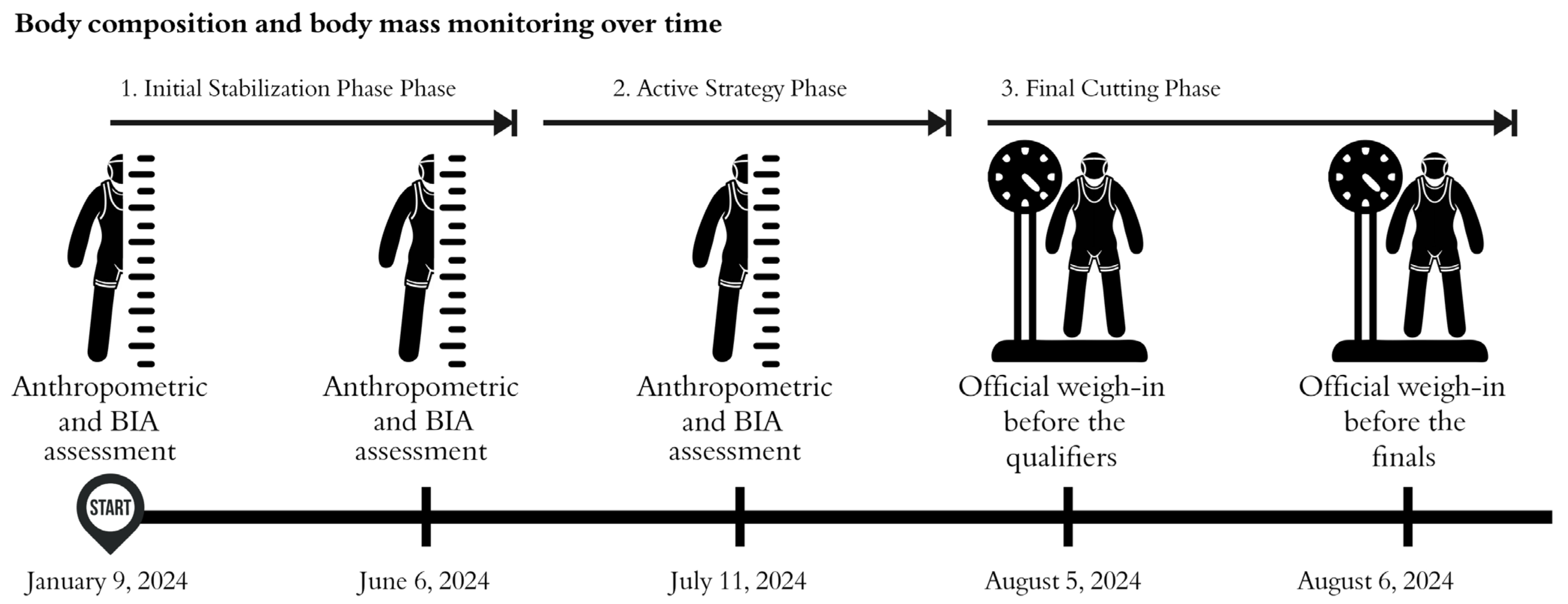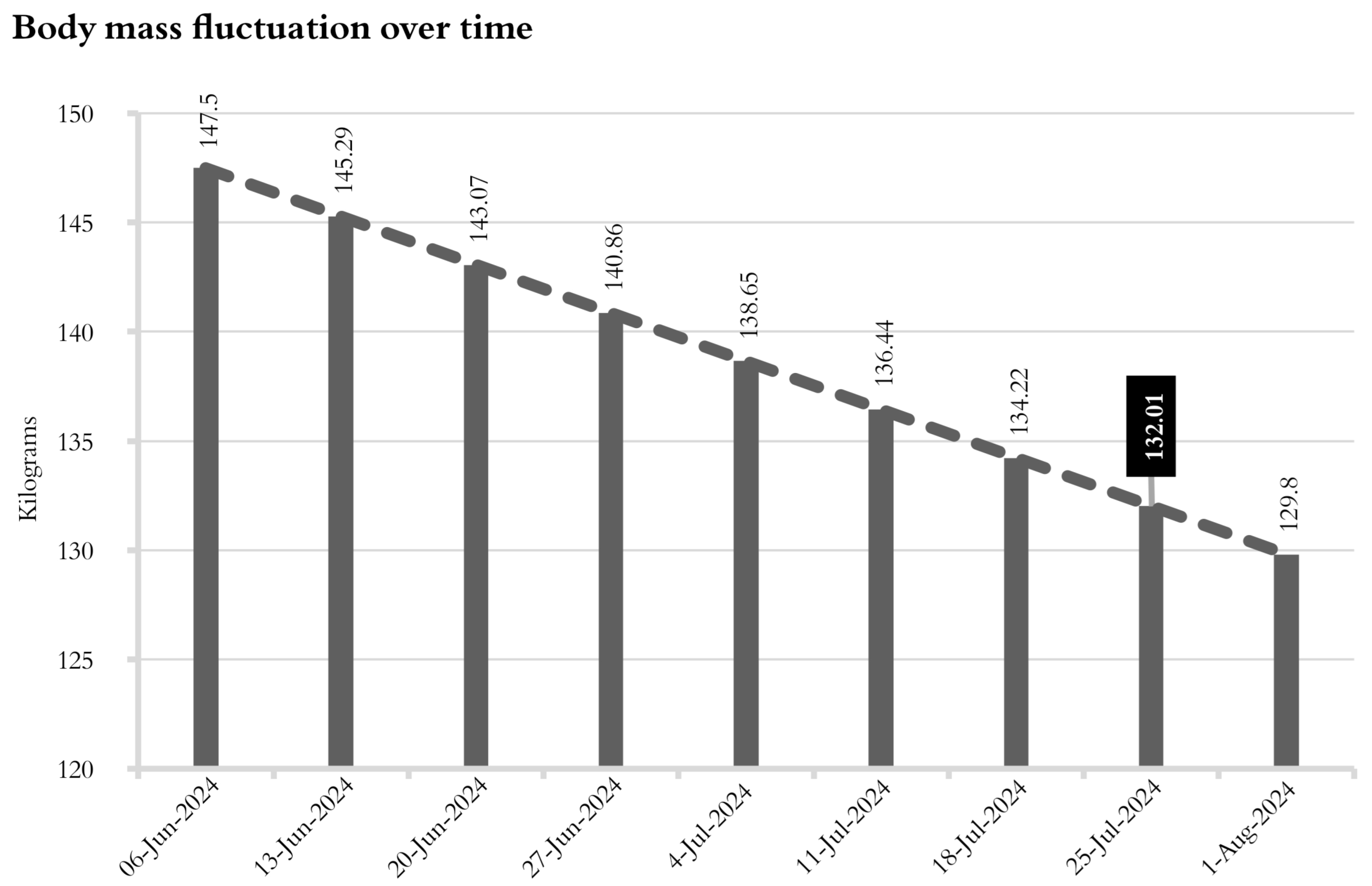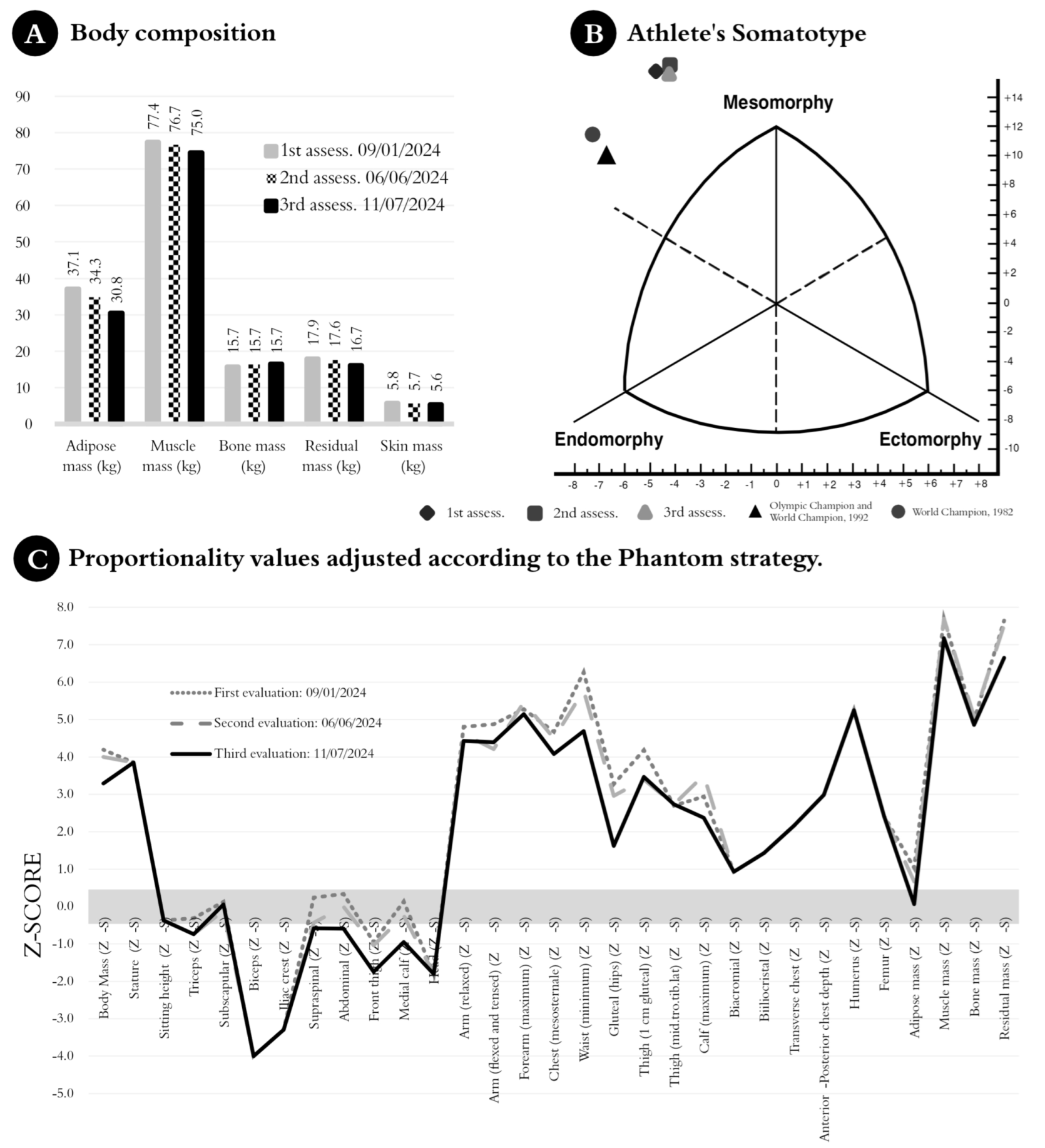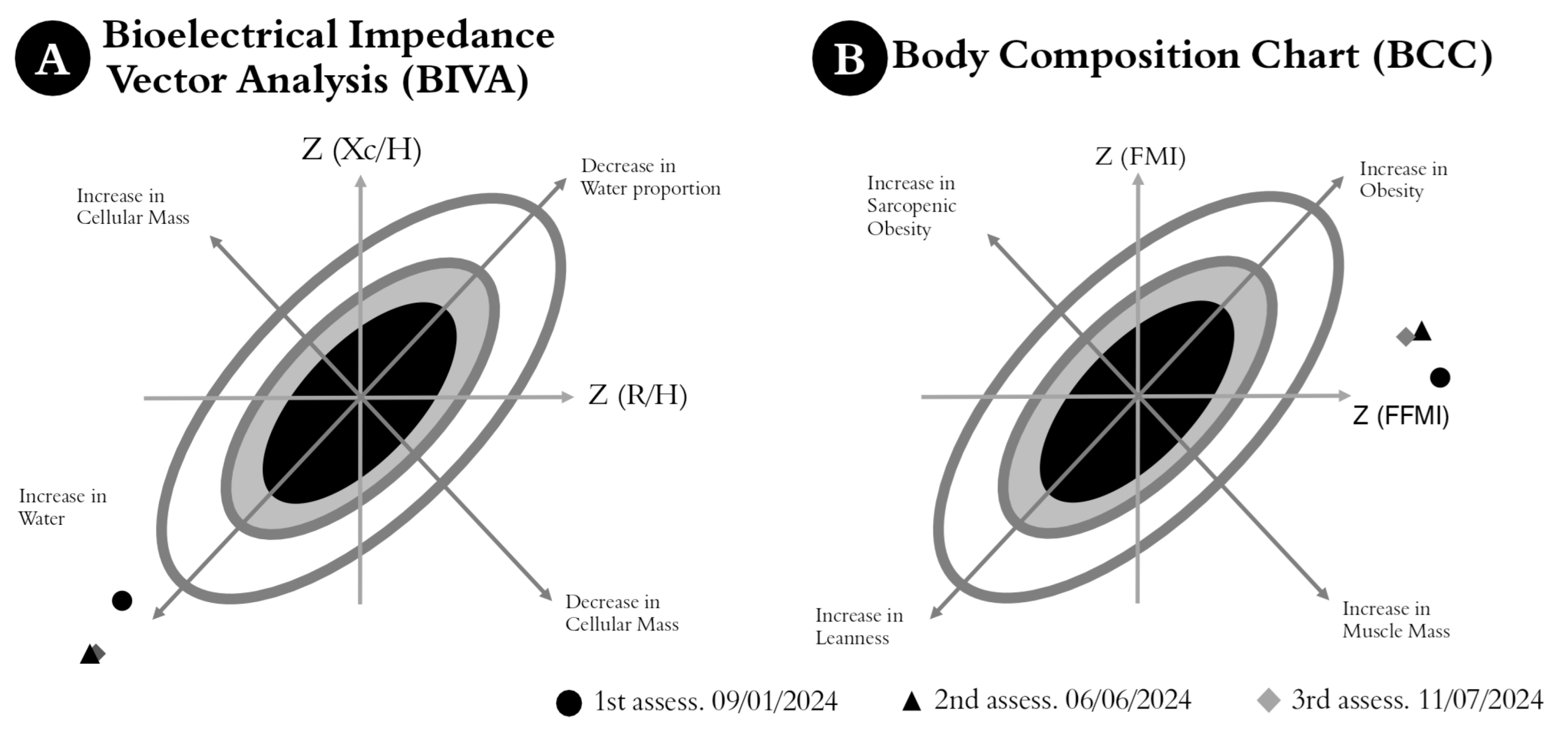Anthropometric Characteristics and Body Composition Changes in a Five-Time Olympic Champion in Greco-Roman Wrestling: A Longitudinal Case Study Towards the Paris 2024 Olympic Games
Abstract
1. Introduction
2. Materials and Methods
2.1. Athlete and Case Study Background
2.2. Nutritional Intervention Strategy
2.3. Experimental Procedures, Measurements, and Data Analysis
2.4. Anthropometric Profile: Body Composition, Somatotype, Indices, and Phantom Proportionality
2.5. Body Composition Assessed by BIA
2.6. Analysis Approach
3. Results
3.1. Anthropometric Profile: Body Composition, Somatotype, Indexes, and Phantom Proportionality
3.2. Anthropometric Parameters: Body Composition, Somatotype, and Proportionality
3.3. Body Composition Assessed by BIA
4. Discussion
4.1. Anthropometric Characteristics of Anthropometric Profile
4.2. Analysis of Body Mass Monitoring
4.3. Limitations
4.4. Implications for Coaches and Practitioners
5. Conclusions
Author Contributions
Funding
Institutional Review Board Statement
Informed Consent Statement
Data Availability Statement
Acknowledgments
Conflicts of Interest
Abbreviations
| BM | Body Mass |
| BIA | Body Electrical Impedance Analysis |
| MWW | Minimum Wrestling Weight |
| BF | Body Fat |
| FFM | Fat-Free Mass |
References
- Chaabene, H.; Negra, Y.; Bouguezzi, R.; Mkaouer, B.; Franchini, E.; Julio, U.; Hachana, Y. Physical and Physiological Attributes of Wrestlers: An Update. J. Strength Cond. Res. 2017, 31, 1411–1442. [Google Scholar] [CrossRef]
- Škugor, K.; Karnincic, H.; Zugaj, N.; Stajer, V.; Gilic, B. Repetition of the Exhaustive Wrestling-Specific Test Leads to More Effective Differentiation between Quality Categories of Youth Wrestlers. Appl. Sci. 2024, 14, 3677. [Google Scholar] [CrossRef]
- Cieśliński, I.; Gierczuk, D.; Sadowski, J. Identification of Success Factors in Elite Wrestlers—An Exploratory Study. PLoS ONE 2021, 16, e0247565. [Google Scholar] [CrossRef] [PubMed]
- Levy, J.J.; Boyd, C. Getting Small to Feel Big: The Psychology of Weight Cutting in Combat Sports. Front. Sports Act. Living 2025, 7, 1495612. [Google Scholar] [CrossRef] [PubMed]
- Lakicevic, N.; Mani, D.; Paoli, A.; Roklicer, R.; Bianco, A.; Drid, P. Weight Cycling in Combat Sports: Revisiting 25 Years of Scientific Evidence. BMC Sports Sci. Med. Rehabil. 2021, 13, 154. [Google Scholar] [CrossRef] [PubMed]
- Lakicevic, N.; Reale, R.; D’Antona, G.; Kondo, E.; Sagayama, H.; Bianco, A.; Drid, P. Disturbing Weight Cutting Behaviors in Young Combat Sports Athletes: A Cause for Concern. Front. Nutr. 2022, 9, 842262. [Google Scholar] [CrossRef]
- Sarıakçalı, B.; Şahin, F.N.; Başoğlu, B.; Ceylan, L.; Güler, Ö.; Yamak, B.; Arıkan, G.; Acar, G.C.; Sekban, G.; Durmuşoğlu, M.V.; et al. The Dual Impact: Physiological and Psychological Effects of Rapid Weight Loss in Wrestling. Front. Psychol. 2025, 15, 1513129. [Google Scholar] [CrossRef]
- Hammer, E.; Sanfilippo, J.L.; Johnson, G.; Hetzel, S. Association of In-Competition Injury Risk and the Degree of Rapid Weight Cutting Prior to Competition in Division I Collegiate Wrestlers. Br. J. Sports Med. 2023, 57, 160–165. [Google Scholar] [CrossRef]
- Marten, A.D.; Mattin, M.D.; Rumps, M.V.; Saraf, S.M.; Mulcahey, M.K. Effects of Rapid Weight Loss in Male and Female Wrestlers. J. Strength Cond. Res. 2025, 39, e721–e729. [Google Scholar]
- Ghaemi, J.; Rashidlamir, A.; Hosseini, R.A. A Comparison of Effects of Rapid and Gradual Weight Loss Methods on Body Composition, Aerobic Capacity, and Anaerobic Power in Trained Wrestlers. Int. J. Wrestl. Sci. 2014, 4, 79–94. [Google Scholar] [CrossRef]
- Kuźmicki, S.; Kruszewski, A.; Kruszewski, M. The effects of body mass reduction on the anaerobic power and selected somatic characteristics of Greco-Roman wrestlers. Biomed. Hum. Kinet. 2023, 15, 35–42. [Google Scholar] [CrossRef]
- Kondo, E.; Sagayama, H.; Yamada, Y.; Shiose, K.; Osawa, T.; Motonaga, K.; Ouchi, S.; Kamei, A.; Nakajima, K.; Higaki, Y.; et al. Energy Deficit Required for Rapid Weight Loss in Elite Collegiate Wrestlers. Nutrients 2018, 10, 536. [Google Scholar] [CrossRef]
- Türkyilmaz, R.; Yarar, H. The Investigation of the Effects of Short-Term Body Weight Loss on Elite Wrestlers on Anaerobic Performance and Reaction Time in Tournament Conditions. J. Sport Sci. Res. 2024, 9, 1–16. [Google Scholar] [CrossRef]
- Ayar, M.; Kucuk-Yetgin, M.; Agopyan, A.; Elmacioglu, F. The Effect of a Nutrition Program for Weight Loss during the Pre-competition Period on the Body Composition, Hydration, and Mood Profile of Elite Greco-Roman Wrestlers. Sport Sci. Health 2023, 19, 1245–1256. [Google Scholar] [CrossRef]
- Okudan, B.; Isik, O.; Akyurek, Z.; Karakullukcu, O.F.; Talaghir, L.G.; Nanu, L. Physiological and Psychological Effects of Weight Loss-Induced Stress before a Competition in Senior Wrestlers. Front. Psychol. 2025, 16, 1568284. [Google Scholar] [CrossRef]
- Trivic, T.; Roklicer, R.; Zenic, N.; Modric, T.; Milovancev, A.; Lukic-Sarkanovic, M.; Maksimovic, N.; Bianco, A.; Carraro, A.; Drid, P. Rapid Weight Loss Can Increase the Risk of Acute Kidney Injury in Wrestlers. BMJ Open Sport Exerc. Med. 2023, 9, e001617. [Google Scholar] [CrossRef]
- Oppliger, R.A.; Case, H.S.; Horswill, C.A.; Landry, G.L.; Shelter, A.C. American College of Sports Medicine position stand. Weight loss in wrestlers. Med. Sci. Sports Exerc. 1996, 28, 135–138. [Google Scholar] [CrossRef] [PubMed]
- Buğrahan, C.; Ahmet, S. The investigation of the weight loss methods and effects on the elite U23 wrestlers. Prog. Nutr. 2020, 22, 88–93. [Google Scholar]
- Drid, P.; Figlioli, F.; Lakicevic, N.; Gentile, A.; Stajer, V.; Raskovic, B.; Vojvodic, N.; Roklicer, R.; Trivic, T.; Tabakov, S.; et al. Patterns of rapid weight loss in elite sambo athletes. BMC Sports Sci. Med. Rehabil. 2021, 13, 39. [Google Scholar] [CrossRef]
- Roklicer, R.; Rossi, C.; Bianco, A.; Stajer, V.; Ranisavljev, M.; Todorovic, N.; Manojlovic, M.; Gilic, B.; Trivic, T.; Drid, P. Prevalence of rapid weight loss in Olympic-style wrestlers. J. Int. Soc. Sports Nutr. 2022, 19, 593–602. [Google Scholar] [CrossRef]
- Kordi, R.; Ziaee, V.; Rostami, M.; Wallace, W.A. Patterns of weight loss and supplement consumption of male wrestlers in Tehran. Sports Med. Arthrosc. Rehabil. Ther. Technol. 2011, 3, 4. [Google Scholar] [CrossRef] [PubMed]
- Zhong, Y.; Song, Y.; Artioli, G.G.; Gee, T.I.; French, D.N.; Zheng, H.; Lyu, M.; Li, Y. The Practice of Weight Loss in Combat Sports Athletes: A Systematic Review. Nutrients 2024, 16, 1050. [Google Scholar] [CrossRef]
- Bagheri, R.; Negaresh, R.; Motevalli, M.S.; Wong, A.; Ashtary-Larky, D.; Kargarfard, M.; Rashidlamir, A. Spirulina supplementation during gradual weight loss in competitive wrestlers. Br. J. Nutr. 2022, 127, 248–256. [Google Scholar] [CrossRef]
- Kondo, E.; Shiose, K.; Osawa, T.; Motonaga, K.; Kamei, A.; Nakajima, K.; Sagayama, H.; Wada, T.; Nishiguchi, S.; Takahashi, H. Effects of an overnight high-carbohydrate meal on muscle glycogen after rapid weight loss in male collegiate wrestlers. BMC Sports Sci. Med. Rehabil. 2021, 13, 96. [Google Scholar] [CrossRef] [PubMed]
- Milovancev, A.; Miljkovic, T.; Ilic, A.; Stojšić-Milosavljević, A.; Petrović, M.; Roklicer, R.; Lakićević, N.; Trivić, T.; Drid, P. Disrupting arrhythmia in a professional male wrestler athlete after rapid weight loss and high-intensity training—Case report. Front. Cardiovasc. Med. 2023, 10, 1091603. [Google Scholar] [CrossRef]
- Yu, L.; Lei, L.; Cheng, L. Influence of slow and rapid weight loss periods on physiological performance, mood state and sleep quality in male freestyle wrestlers: A study from Sichuan Province, China. Front. Psychol. 2024, 15, 1445810. [Google Scholar] [CrossRef] [PubMed]
- Ross, W.; Kerr, D.A. Fraccionamiento de la masa corporal: Un nuevo método para utilizar en nutrición clínica y medicina deportiva. Apunt. Med. l’Esport 1991, 28, 175–187. [Google Scholar]
- Reijic, D.; Hässler, E.; Jost, J.; Friedmann-Bette, B. Rapid weight loss and the body fluid balance and hemoglobin mass of elite amateur boxers. J. Athl. Train. 2013, 48, 109–117. [Google Scholar]
- Campa, F.; Toselli, S.; Mazzilli, M.; Gobbo, L.A.; Coratella, G. Assessment of Body Composition in Athletes: A Narrative Review of Available Methods with Special Reference to Quantitative and Qualitative Bioimpedance Analysis. Nutrients 2021, 13, 1620. [Google Scholar] [CrossRef]
- De la Cruz Marcos, S.; Redondo del Río, M.P.; de Mateo Silleras, B. Applications of Bioelectrical Impedance Vector Analysis (BIVA) in the Study of Body Composition in Athletes. Appl. Sci. 2021, 11, 9781. [Google Scholar] [CrossRef]
- Marantz, K. Paris 2024 Preview: Day 1 at GR 60 kg, 130 kg & WW 68 kg. United World Wrestling. 22 July 2024. Available online: https://uww.org/article/paris-2024-preview-day-gr-60kg-130kg-ww-68kg (accessed on 4 February 2025).
- World Medical Association. World Medical Association Declaration of Helsinki: Ethical Principles for Medical Research Involving Human Participants. JAMA 2025, 333, 71–74. [Google Scholar] [CrossRef] [PubMed]
- Gagnier, J.J.; Kienle, G.; Altman, D.G.; Moher, D.; Sox, H.; Riley, D.; CARE Group. The CARE guidelines: Consensus-based clinical case reporting guideline development. BMJ Case Rep. 2013, 53, 1541–1547. [Google Scholar]
- Reale, R.; Slater, G.; Burke, L.M. Individualised dietary strategies for Olympic combat sports: Acute weight loss, recovery and competition nutrition. Eur. J. Sport Sci. 2017, 17, 727–740. [Google Scholar] [CrossRef] [PubMed]
- Esparza Ros, F.; Vaquero-Cristóbal, R.; Marfell-Jones, M. International Standards for Anthropometric Assessment; International Society for the Advancement of Kinanthropometry (ISAK): Murcia, Spain, 2019; 114p. [Google Scholar]
- Ross, W.; Wilson, N.C. A stratagem for proportional growth assessment. Acta Paediatr. Belg. 1974, 28, 169–182. [Google Scholar]
- Lohman, T.G. Skinfolds and body density and their relation to body fatness: A review. Hum. Biol. 1981, 53, 181–225. [Google Scholar] [PubMed]
- Carter, J. The Heath-Carter Anthropometric Somatotype Instruction Manual; Department of Exercise and Nutritional Sciences, San Diego State University: San Diego, CA, USA, 2002. [Google Scholar]
- Bosy-Westphal, A.; Schautz, B.; Later, W.; Kehayias, J.J.; Gallagher, D.; Müller, M.J. What makes a BIA equation unique? Validity of eight-electrode multifrequency BIA to estimate body composition in a healthy adult population. Eur. J. Clin. Nutr. 2013, 67, S14–S21. [Google Scholar] [CrossRef]
- Stratton, M.T.; Smith, R.W.; Harty, P.S.; Rodriguez, C.; Johnson, B.A.; Dellinger, J.R.; Williams, A.D.; White, S.J.; Benavides, M.L.; Tinsley, G.M. Longitudinal agreement of four bioimpedance analyzers for detecting changes in raw bioimpedance during purposeful weight gain with resistance training. Eur. J. Clin. Nutr. 2021, 75, 1060–1068. [Google Scholar] [CrossRef] [PubMed]
- Lahav, Y.; Goldstein, N.; Gepner, Y. Comparison of body composition assessment across body mass index categories by two multifrequency bioelectrical impedance analysis devices and dual-energy X-ray absorptiometry in clinical settings. Eur. J. Clin. Nutr. 2021, 75, 1275–1282. [Google Scholar] [CrossRef]
- Kushner, R.F.; Gudivaka, R.; Schoeller, D.A. Clinical characteristics influencing bioelectrical impedance analysis measurements. Am. J. Clin. Nutr. 1996, 64, 423S–427S. [Google Scholar] [CrossRef]
- Škugor, K.; Gilić, B.; Karninicic, H.; Jokai, M.; Babszky, G.; Ranisavljev, M.; Štajer, V.; Roklicer, R.; Drid, P. What determines the competitive success of young Croatian wrestlers: Anthropometric indices, generic or specific fitness performance? J. Funct. Morphol. Kinesiol. 2023, 8, 90. [Google Scholar] [CrossRef]
- Reale, R.; Burke, L.M.; Cox, G.R.; Slater, G. Body composition of elite Olympic combat sport athletes. Eur. J. Sport Sci. 2020, 20, 147–156. [Google Scholar] [CrossRef] [PubMed]
- Sterkowicz-Przybycień, K.L.; Sterkowicz, S.; Żarów, R.T. Somatotype, body composition and proportionality in Polish top Greco-Roman wrestlers. Hum. Kinet. 2011, 28, 141–154. [Google Scholar] [CrossRef] [PubMed]
- Baranauskas, M.; Kupčiūnaitė, I.; Lieponienė, J.; Stukas, R. Dominant somatotype development in relation to body composition and dietary macronutrient intake among high-performance athletes in water, cycling and combat sports. Nutrients 2024, 16, 1493. [Google Scholar] [CrossRef]
- Rahmani, F.; Mirzaei, B.; Faradjzadeh-Mevaloo, S. Anthropometric profile of elite Azerbaijani senior Greco-Roman wrestlers. Pedagog. Psychol. Med. Biol. Probl. Phys. Train. Sports 2019, 23, 196–201. [Google Scholar] [CrossRef]
- Carvajal-Veitía, W.; León-Pérez, S.; González-Revuelta, M.E.; Deturnel-Campo, Y.; Echavarría-García, Y. Anthropometrical characteristics of Cuban sporting population: Reference data from a high performance national teams, 1992–2014. Apunt. Med. Esport 2018, 53, 129–137. [Google Scholar] [CrossRef]
- Jagim, A.R.; Tinsley, G.M.; Merfeld, B.R.; Ambrosius, A.; Khurelbaatar, C.; Dodge, C.; Carpenter, M.; Luedke, J.; Erickson, J.L.; Fields, J.B.; et al. Validation of skinfold equations and alternative methods for the determination of fat-free mass in young athletes. Front. Sports Act. Living 2023, 5, 1240252. [Google Scholar] [CrossRef] [PubMed]
- Donmez, E.; Isik, O.; Baic, M. Fluctuation in body composition and urine specific gravity of Turkish wrestlers in a top-level official wrestling competition. Front. Physiol. 2025, 15, 1516149. [Google Scholar] [CrossRef]
- Marini, E.; Campa, F.; Buffa, R.; Stagi, S.; Matias, C.N.; Toselli, S.; Sardinha, L.B.; Silva, A.M. Phase angle and bioelectrical impedance vector analysis in the evaluation of body composition in athletes. Clin. Nutr. 2020, 39, 447–454. [Google Scholar] [CrossRef]
- Campa, F.; Matias, C.N.; Marini, E.; Heymsfield, S.B.; Toselli, S.; Sardinha, L.B.; Silva, A.M. Identifying athlete body fluid changes during a competitive season with bioelectrical impedance vector analysis. Int. J. Sports Physiol. Perform. 2020, 15, 361–367. [Google Scholar] [CrossRef]
- Zhang, J.; Zhang, N.; Li, Y.; He, H.; Song, G.; Chen, J.; Yan, Y.; Ma, G. Habitual water intake impacted the body composition of young male athletes in free-living conditions: A cross-sectional study. Front. Sports Act. Living 2024, 6, 1458242. [Google Scholar] [CrossRef]
- Canda, A. Muscle mass index estimated by anthropometry vs bioelectrical impedance: Study in athletes competing by weight categories. Apunt. Sports Med. 2021, 56, 100360. [Google Scholar] [CrossRef]
- Caparello, G.; Galluccio, A.; Ceraudo, F.; Pecorella, C.; Buzzanca, F.; Cuccomarino, F.; Bonofiglio, D.; Avolio, E. Evaluation of body composition changes by bioelectrical impedance vector analysis in volleyball athletes following Mediterranean diet recommendations during Italian Championship: A pilot study. Appl. Sci. 2023, 13, 2794. [Google Scholar] [CrossRef]
- Campa, F.; Thomas, D.M.; Watts, K.; Clark, N.; Baller, D.; Morin, T.; Toselli, S.; Koury, J.C.; Melchiorri, G.; Andreoli, A.; et al. Reference percentiles for bioelectrical phase angle in athletes. Biology 2022, 11, 264. [Google Scholar] [CrossRef] [PubMed]
- Bennett, J.P.; Cataldi, D.; Liu, Y.E.; Kelly, N.N.; Quon, B.K.; Gonzalez, M.C.; Heymsfield, S.B.; Shepherd, J. Variations in bioelectrical impedance devices impact raw measures comparisons and subsequent prediction of body composition using recommended estimation equations. Clin. Nutr. ESPEN 2024, 63, 540–550. [Google Scholar] [CrossRef]
- Cirillo, E.; Pompeo, A.; Cirillo, F.T.; Vilaça-Alves, J.; Costa, P.; Ramirez-Campillo, R.; Dourado, A.C.; Afonso, J.; Casanova, F. Relationship between bioelectrical impedance phase angle and upper and lower limb muscle strength in athletes from several sports: A systematic review with meta-analysis. Sports 2023, 11, 107. [Google Scholar] [CrossRef]
- Lebron, M.A.; Stout, J.R.; Fukuda, D.H. Physiological perturbations in combat sports: Weight cycling and metabolic function—A narrative review. Metabolites 2024, 14, 83. [Google Scholar] [CrossRef]
- Karnincic, H.; Žugaj, N.; Škugor, K. Advice on regulating body mass in wrestling from the most cited combat sport literature—A systematic review. J. Funct. Morphol. Kinesiol. 2024, 9, 264. [Google Scholar] [CrossRef]




| Variables | Eval 1 (9 January 24) | Eval 2 (6 June 24) | Eval 3 (11 July 24) | Change 1→2 (%) | Change 2→3 (%) | Change 1→3 (%) |
|---|---|---|---|---|---|---|
| Body mass (kg) | 150 | 147.5 | 138.5 | −1.6 | −6.1 | −7.6 |
| Body composition | ||||||
| Adipose mass (kg) | 37.1 | 34.3 | 30.8 | −7.5 | −10.2 | −17.0 |
| Adipose (%) | 24.1 | 22.9 | 21.4 | −5.0 | −6.6 | −11.2 |
| Muscle mass (kg) | 77.4 | 76.7 | 75 | −0.9 | −2.2 | −3.1 |
| Muscle (%) | 50.3 | 51.1 | 52.2 | 1.6 | 2.2 | 3.8 |
| Bone mass (kg) | 15.7 | 15.7 | 15.7 | 0.0 | 0.0 | 0.0 |
| Bone (%) | 10.2 | 10.5 | 10.9 | 2.9 | 3.8 | 6.9 |
| Residual mass (kg) | 17.9 | 17.6 | 16.7 | −1.7 | −5.1 | −6.7 |
| Residual (%) | 11.6 | 11.7 | 11.6 | 0.9 | −0.9 | 0.0 |
| Skin mass (kg) | 5.8 | 5.7 | 5.6 | −1.7 | −1.8 | −3.4 |
| Skin (%) | 3.8 | 3.8 | 3.9 | 0.0 | 2.6 | 2.6 |
| Body Fat Lohman (kg) | 34.4 | 32.2 | 27.0 | −6.4 | −16.1 | −27.4 |
| Body Fat Lohman (%) | 22.2 | 21.8 | 19.5 | −1.8 | −10.6 | −13.8 |
| FFM Lohman (kg) | 115.6 | 115.3 | 111.5 | −0.25 | −3.29 | −3.54 |
| Somatotype | ||||||
| Endomorphy | 4.9 | 4.3 | 4.3 | −12.2 | 0.0 | −12.2 |
| Mesomorphy | 10.4 | 10.4 | 10.1 | 0.0 | −2.9 | −2.9 |
| Ectomorphy | 0.1 | 0.1 | 0.1 | 0.0 | 0.0 | 0.0 |
| X | −4.8 | −4.2 | −4.2 | −12.5 | 0.0 | −12.5 |
| Y | 15.9 | 16.4 | 15.8 | 3.1 | −3.7 | −0.6 |
| Corrected girths (cm) | ||||||
| Arm | 38.5 | 38.7 | 38.2 | 0.5 | −1.3 | −0.8 |
| Chest | 121.6 | 121 | 118.2 | −0.5 | −2.3 | −2.8 |
| Thigh | 77.2 | 73.6 | 76 | −4.7 | 3.3 | −1.6 |
| Calf | 42 | 44.2 | 42.4 | 5.2 | −4.1 | 1.0 |
| Indexes | ||||||
| BMI (kg/m2) | 39.7 | 39 | 36.6 | −1.8 | −6.2 | −7.8 |
| AKS (g/cm3) | 1.55 | 1.57 | 1.52 | 1.3 | −3.2 | −1.9 |
| WHR | 0.6 | 0.6 | 0.5 | 0.0 | −16.7 | −16.7 |
| HBBI | 23.4 | 23.4 | 23.4 | 0.0 | 0.0 | 0.0 |
| HBiiL | 5.4 | 5.4 | 5.4 | 0.0 | 0.0 | 0.0 |
| BBI | 1.3 | 1.3 | 1.3 | 0.0 | 0.0 | 0.0 |
| MBR | 4.9 | 4.9 | 4.8 | 0.0 | −2.0 | −2.0 |
| AMR | 0.5 | 0.4 | 0.4 | −20.0 | 0.0 | −20.0 |
| Cormic index | 51.9 | 51.9 | 51.9 | 0.0 | 0.0 | 0.0 |
| Thoracic index | 68.2 | 68.2 | 68.2 | 0.0 | 0.0 | 0.0 |
| Other | ||||||
| ∑6SKF (mm) † | 128 | 115.2 | 99.6 | −10.0 | −13.5 | −22.2 |
| ∑4CG (mm) ‡ | 316.5 | 315 | 311.8 | −0.5 | −1.0 | −1.5 |
| Variables | Eval 1 | Eval 2 | Eval 3 | Change 1→2 (%) | Change 2→3 (%) | Change 1→3 (%) |
|---|---|---|---|---|---|---|
| (9 January 4) | (6 June 4) | (11 July 24) | ||||
| Cellular level | ||||||
| PA (°) | 6.1 | 5.6 | 5.6 | 8.2 | 0 | 8.2 |
| ECW (L) | 31.8 | 34.3 | 34.4 | 7.9 | 0.3 | 8.2 |
| ECW (%) | 21 | 23.5 | 24.7 | 11.9 | 5.1 | 17.6 |
| ICW (L) | 39.1 | 47.8 | 46.9 | 22.3 | −1.9 | 19.9 |
| ICW (%) | 29.3 | 31.6 | 34.1 | 7.8 | 7.9 | 16.4 |
| ICW/ECW | 1.22 | 1.39 | 1.36 | 13.9 | −2.2 | 11.5 |
| ECW/ICW | 0.81 | 0.72 | 0.73 | −0.11 | 0.01 | −0.09 |
| Xc (Ω) | 40.9 | 32.4 | 32.4 | −20.8 | 0 | −20.8 |
| Molecular level | ||||||
| TBW (L) | 70.9 | 82.1 | 81.3 | 15.8 | −1 | 14.7 |
| TBW (%) | 50.3 | 50.3 | 58.8 | 0 | 16.9 | 16.9 |
| R (Ω) | 380.7 | 342.4 | 333.1 | −10.1 | −2.7 | −11.5 |
| FMI (kg/Ht2) | 12.68 | 9.85 | 7.59 | −22.3 | −22.9 | −40.1 |
| FFMI (kg/Ht2) | 27.01 | 29.19 | 27.45 | 8.1 | 6 | −1.6 |
Disclaimer/Publisher’s Note: The statements, opinions and data contained in all publications are solely those of the individual author(s) and contributor(s) and not of MDPI and/or the editor(s). MDPI and/or the editor(s) disclaim responsibility for any injury to people or property resulting from any ideas, methods, instructions or products referred to in the content. |
© 2025 by the authors. Licensee MDPI, Basel, Switzerland. This article is an open access article distributed under the terms and conditions of the Creative Commons Attribution (CC BY) license (https://creativecommons.org/licenses/by/4.0/).
Share and Cite
Carvajal-Veitía, W.; Herrera-Amante, C.A.; Yáñez-Sepúlveda, R.; Gainza-Pérez, V.; Deturnell-Campos, Y.; Cristi-Montero, C.; Cortés-Roco, G.; Ramos-García, C.O. Anthropometric Characteristics and Body Composition Changes in a Five-Time Olympic Champion in Greco-Roman Wrestling: A Longitudinal Case Study Towards the Paris 2024 Olympic Games. J. Funct. Morphol. Kinesiol. 2025, 10, 176. https://doi.org/10.3390/jfmk10020176
Carvajal-Veitía W, Herrera-Amante CA, Yáñez-Sepúlveda R, Gainza-Pérez V, Deturnell-Campos Y, Cristi-Montero C, Cortés-Roco G, Ramos-García CO. Anthropometric Characteristics and Body Composition Changes in a Five-Time Olympic Champion in Greco-Roman Wrestling: A Longitudinal Case Study Towards the Paris 2024 Olympic Games. Journal of Functional Morphology and Kinesiology. 2025; 10(2):176. https://doi.org/10.3390/jfmk10020176
Chicago/Turabian StyleCarvajal-Veitía, Wiliam, Carlos Abraham Herrera-Amante, Rodrigo Yáñez-Sepúlveda, Vladimir Gainza-Pérez, Yanell Deturnell-Campos, Carlos Cristi-Montero, Guillermo Cortés-Roco, and César Octavio Ramos-García. 2025. "Anthropometric Characteristics and Body Composition Changes in a Five-Time Olympic Champion in Greco-Roman Wrestling: A Longitudinal Case Study Towards the Paris 2024 Olympic Games" Journal of Functional Morphology and Kinesiology 10, no. 2: 176. https://doi.org/10.3390/jfmk10020176
APA StyleCarvajal-Veitía, W., Herrera-Amante, C. A., Yáñez-Sepúlveda, R., Gainza-Pérez, V., Deturnell-Campos, Y., Cristi-Montero, C., Cortés-Roco, G., & Ramos-García, C. O. (2025). Anthropometric Characteristics and Body Composition Changes in a Five-Time Olympic Champion in Greco-Roman Wrestling: A Longitudinal Case Study Towards the Paris 2024 Olympic Games. Journal of Functional Morphology and Kinesiology, 10(2), 176. https://doi.org/10.3390/jfmk10020176











